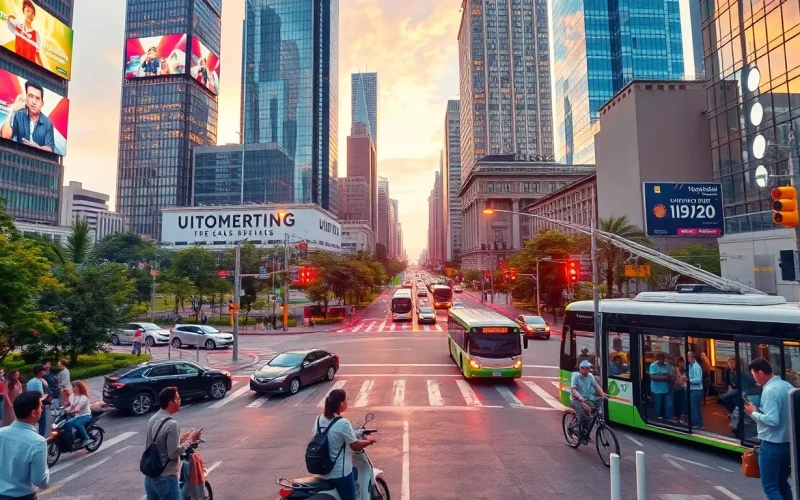Table of Contents
ToggleImagine a world where traffic jams are a thing of the past, streetlights know when to turn on, and your fridge can order milk all by itself. Welcome to the era of smart cities, where technology meets urban living in the most delightful way. With the rise of the “G” generation—think 5G and beyond—cities are evolving into interconnected ecosystems that promise efficiency, sustainability, and a sprinkle of futuristic charm.
Smart cities aren’t just about fancy gadgets and flashy apps. They’re about creating a harmonious environment that enhances quality of life. From reducing energy consumption to improving public transport, the benefits are as vast as the sky on a clear day. So buckle up as we explore how the “G” in smart cities is transforming urban landscapes into thriving hubs of innovation and connectivity. Who knew the future could be this fun?
Overview of G for Smart Cities
G stands for the latest generation of wireless technology pivotal in the evolution of smart cities. This advanced network supports numerous applications that enhance connectivity, efficiency, and sustainability within urban areas. Enhanced data transfer rates facilitate real-time communication between devices, enabling seamless integration of services.
Smart city infrastructure benefits significantly from low latency characteristics of G technology. Faster response times improve public safety systems such as emergency services and surveillance. Enhanced connectivity also optimizes traffic management systems, leading to reduced congestion and lower emissions.
Incorporating G technology into smart cities fosters innovative solutions for energy management. Smart grids utilize G-enabled sensors to monitor consumption patterns, resulting in improved energy distribution and minimized waste. Building management systems can adjust energy use based on occupancy and weather conditions, ensuring maximum efficiency.
The integration of G in public transport systems transforms user experiences. Real-time tracking features provide commuters with accurate arrival times, reducing wait periods and enhancing overall satisfaction. Mobile applications allow users to plan routes and receive updates on delays, further improving efficiency.
Furthermore, G technology enhances citizen engagement through smart applications. IoT devices collect data regarding environmental conditions, enabling residents to report issues such as waste management or air quality. Governments can address citizen concerns more effectively, fostering trust and collaboration.
In sum, G technology plays a crucial role in shaping smart cities. The innovation bolsters connectivity while promoting sustainability and efficiency. Continuous evolution and adoption of G solutions are vital for creating urban environments that meet the needs of growing populations.
Key Features of G for Smart Cities

The integration of G technology significantly enhances smart cities. This technology provides critical improvements in connectivity and data management.
Connectivity Enhancements
5G technology delivers enhanced connectivity, impacting various aspects of urban infrastructure. Enabled devices provide faster internet access, supporting IoT devices throughout the city. Continuous data flow from connected sensors optimizes traffic lights, improving traffic flow and reducing congestion. Increased network reliability plays a vital role in emergency communications, ensuring public safety measures function effectively. Ultimately, these advancements contribute to a more interconnected urban environment, promoting overall efficiency.
Data Management Solutions
Advanced data management solutions arise from the implementation of G technologies. Improved analytics tools assist city planners in making data-driven decisions. Real-time data collection empowers local governments to address residents’ needs quickly. Enhanced data storage capabilities enable secure handling of vast information from diverse sources. Effective data management fosters solutions like smart energy grids, reducing energy consumption and emissions. These coordinated efforts lead to a sustainable and responsive urban landscape.
Benefits of G for Smart Cities
G technology significantly enhances smart cities by improving overall functionality and fostering a better quality of life. Its impact spans various areas, including efficiency and sustainability.
Improved Efficiency
In smart cities, G enables seamless communication between devices, enhancing operational productivity. Real-time data sharing allows city services to optimize energy use, reducing waste. Traffic lights can adjust based on current flow, minimizing congestion. Enhanced connectivity leads to improved public safety with quicker emergency responses. It empowers reliable public transport systems, ensuring timely information reaches commuters. Automatic management of street lighting based on pedestrian activity helps in conserving energy.
Enhanced Sustainability
Sustainability efforts get boosted through G technology in smart cities. Smart grids, supported by this technology, allow for better energy management and integration of renewable sources. Waste management systems use real-time data to optimize collection routes, reducing carbon footprints. Water usage can be monitored and controlled more effectively via smart metering systems, promoting conservation. Urban green spaces benefit from data-driven planning, enhancing biodiversity and air quality. Communities gain insights into environmental health, empowering residents to participate in sustainability initiatives.
Challenges and Considerations
Implementing smart cities presents significant challenges that require careful consideration. Addressing implementation barriers and security concerns remains crucial.
Implementation Barriers
Limited funding poses a primary obstacle for many cities. Budget constraints often hinder progress in smart infrastructure projects. Technical expertise also falls short, with cities lacking skilled personnel for advanced technology deployment. Fragmented data systems complicate seamless integration, making collaboration difficult. Regulatory hurdles can slow the adoption of new technologies, delaying benefits. Operational changes need coordination across multiple agencies, hindering unified efforts. Addressing these barriers proactively enhances the successful integration of smart solutions.
Security Concerns
Privacy issues emerge as a top priority in smart city development. Citizens express apprehension over data collection practices, fearing surveillance and misuse. Cybersecurity threats pose risks to critical infrastructure, from transportation systems to energy grids. Safeguarding sensitive information becomes essential to maintain public trust. Furthermore, potential attacks on IoT devices can lead to vulnerabilities in essential services. Developing robust security measures helps mitigate these risks while ensuring safe, effective smart city operations.
Future Trends in G for Smart Cities
5G technology continually evolves, paving the way for future developments in smart cities. Advances in connectivity will support emerging solutions, enhancing urban life and sustainability. Economic growth could significantly benefit as cities utilize 5G to foster innovation in transportation, healthcare, and public safety.
Urban planners are increasingly leveraging data analytics for informed decision-making. Real-time data sharing ensures efficient traffic management systems adapt swiftly to changing conditions. Connected IoT devices collect information about urban environments, facilitating better resource management and improved public safety measures.
Resilience in infrastructure remains a priority as cities adopt smart technologies. Smart grids will improve energy distribution and reduce waste, while IoT-enabled devices promote efficient water management and waste collection processes. Continuous advancements in AI and machine learning integrate with 5G, optimizing city operations and service delivery.
Citizen engagement through digital platforms is expected to grow. Residents will increasingly participate in decision-making processes, providing feedback via IoT systems. Platforms for reporting issues will enhance community interaction, ensuring that services address public needs effectively.
Strengthening cybersecurity will remain critical in this evolving landscape. Cities will invest in robust security measures to protect sensitive information from potential threats. Privacy concerns will necessitate transparent data handling practices, cultivating trust amongst residents.
Investments in infrastructure and training will facilitate the integration of new technologies. Collaboration between public agencies and private enterprises will garner necessary resources and expertise. The development of interoperable systems will further enhance the interconnectedness of smart city components, driving efficiency and sustainability in future urban environments.
The evolution of smart cities, fueled by advancements in 5G technology, promises a transformative impact on urban living. As cities embrace this technology, they’re not just enhancing connectivity but also fostering sustainability and efficiency. The integration of smart solutions paves the way for improved public services, optimized resource management, and engaged communities.
However, challenges remain that require attention and collaboration among stakeholders. Addressing funding limitations, regulatory hurdles, and security concerns will be essential for realizing the full potential of smart cities. With strategic investments and a focus on innovation, urban landscapes can become more resilient and responsive, ultimately enhancing the quality of life for all residents. The future of smart cities is bright, and its success hinges on collective efforts to harness technology for the greater good.





